By Brian Hibbs
I’m a little bored with continually talking about Marvel comics and “Legacy” – there’s not a lot more to say about them now until we get into the sell-through phase in about two months.
So, what else is in the comics news?
One publisher that caught my eye was IDW, with two interesting topics that have come up in the last week. First off, as the rare publicly-traded company, IDW is required to file regular profit/loss statements, and ICv2 has the story. The thing that caught my eye here is the statement from the article: “Two main causes were cited for the reduction in publishing sales. First was ‘industry cyclical downward pressure driven by market leaders’ (translation: Marvel’s not doing well and it’s hurting store traffic and our sales)”
While this statement might, sort of, make some kind of sense on a certain level, I think it completely misunderstands how retailers buy comics in 2017. I’ve heard this theory many times in my life: If Marvel and DC are doing well, then there is more cash in the marketplace to “experiment” with. The problem with this formulation is that is largely implies that retailers don’t actually know what they are doing: that they’re essentially throwing darts at a board randomly and seeing what sticks.
Well, actually, sure, that’s what we do in some cases (typically: brand new series/creative teams with no history or knowledge of any kind), but for the most part, that’s 1996 thinking (or maybe even 1986!) – before point-of-sale systems (POS) were widespread, and back when the “platonic ideal” was trying to be all things to all customers, where basically all comic stores tried to carry all comics from all publishers. The thing is, that paradigm vaporized (at least) a decade ago, mostly in the face of changing distribution and publishing models which favor over-expansion past what the market could naturally support.
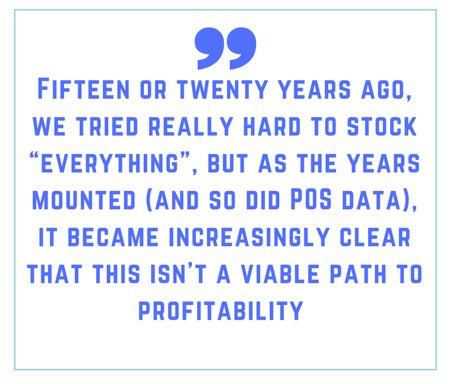
For example, at my main store, there are at least nine different ongoing series published by DC comics that we don’t rack at all (plus a staggering sixty-three variant covers on periodicals, and eleven different graphic novels in series that we’ve also ditched, that’s just on the single newest order form), while Marvel is looking at zero shelf sales on seven of their ongoing series (with a preposterous eighty-six variant covers and seventeen GN series on the newest order form, sheesh) – the penetration is even worse at the smaller store. And that’s only looking at series. When you count one-shots, then the numbers drop further.
Once you realize you don’t need to carry everything DC and Marvel publish, you’re liberated as a Direct Market retailer. And here’s the thing: one only really needs to glance at the sales charts to show that most retailers are now liberated – when both publishers have scores of comics that don’t sell any better than “small press” books, then it becomes fairly clear that the overwhelming majority of stores simply aren’t racking every books from the “big two”.
What’s funny is that in recent times for most stores, trying to rack each and every thing that the “big two” produce is actually much more likely to depress cash flow, and make you less likely (both from profit as well as rack space) to be able to order “small press” books – DC and Marvel both effectively try to “flood out” smaller publishers. So to the extent that “market leaders” are under-preforming, that’s actually more opportunity for the “small press”.
So, what IS the problem at IDW, then? I’d say it stems from two major issues.
First and foremost, it’s from the lack of identity and direction that the publisher has (though they’re not the only one with this problem) – can anyone define what “an IDW comic” is? I can, I think, pretty clearly define what a “Marvel” comic is, what an “Image” comic is, what a “Fantagraphics” comic is, and so on – but I wouldn’t even really know how to begin to define IDW. A lot of what they are is a licensed comics factory (with ends aimed both at kids, like with the Disney license, and adults, like with much of the Hasbro licenses – places where the units don’t really cross-polinate), but they also do a ton of idiosyncratic creator owned works. In addition, they’re the publisher of record for multiple imprints, like Top Shelf, Yoe Books, Eurocomics, The Library of American Comics, Black Crown and now Woodworks – essentially none of which that support each other by being good “cross-sells”, and most of which, I would argue, detract strongly from finding a specific voice, or addressing a specific market. Plus in the last year or three, they’ve been aggressively trying to become a game publisher, too.
I suppose one can make the assertion that this could be a strength, in the sense that they have “something for everyone”, but I’ve always been more partial to the notion of “Jack of all trades, means master of none”; and at the end of the day I strongly believe that being all over the map means that its significantly harder to attract an audience for anything that’s not a natural and native seller on its own. In this sense, I strongly think that IDW’s diverse backlist works hard against itself because there’s very little synergy moving them forward. There’s essential no category that IDW trucks in (Licensed comics, creator-owned work, European reprints, classic reprints, “alternative” comics, “sophisticated suspense”, etc.) where I would consider them the market leader, despite having some excellent material in each one of those segments. And if you’re not leading in a category, in Direct Market 2017, it’s much harder to capture mindshare, and thus to succeed and grow as a result.
IDW’s other problem that I think they have is the “one more series” problem. There’s not a license that I can see where IDW isn’t happy, if not downright eager to add “one more series” to the publishing schedule. Oh, that license had a strong launch? Let’s add a second book to the lineup! Hey, the second one is doing OK? Let’s add a third! Mm, and maybe let’s make that a weekly mini-series! Line proliferation and over-expansion is the king at IDW, and while that can work (for a while), if you’ve got exceptionally strong content or brands, I think very little of their licensed comics production has been exceptionally strong in quite a long time.
IDW also has a habit of over-prolonging weak licenses by restarting them over and over again – and, again, they’re far from the only publisher that does this, it’s just they do it with what seems like such reckless abandon. And, look, it works, in the short term, but in the long-term it just dilutes and weakens the audience of the license over all.
I get it, with those last two points, I really do – licensed comics is kind of a shitty business to be in: the money that you’re paying to the licensee is money that can’t go for creative, or be retained as profit, and a whole lot of licenses are only really marginally profitable to begin with. Plus, the worst rub of all is that you the publisher don’t actually own any of the finished work – the licensor does, and can pull it away from you at any time, and just hand all of the work you do to someone else for no additional compensation! (EG: Dark Horse’s “Star Wars” material all being published with a Marvel logo today; or how IDW lost “Doctor Who” to Titan and “Angel” to Dark Horse). The math is such that being so aggressive that even though you might do harm to your own long-term commerciality looks like a real short-term sensible strategy, especially when “the market leader” is mostly following a similar strategy of pump&dump.
But all if this means that IDW looks kind of like a hot mess to the average retailer’s eyes – there’s no real throughline on “what” the publisher is, and since the baseline quality (and commerciality) of material is all over the map as a result of publishing decisions, there’s not a major incentive for retailers to invest. Better still that we also stay lean and cheap on our orders, right?
It’s not “Marvel’s fault”, or a “market softening” or anything even slightly like any of that, however.
In point of fact, when the “Market leaders” screw up is when the smaller presses have their greatest opportunities as retailers cast about looking for books to invest in (got to make the money up some way!)
End of the day: the point I wanted to make here is that DM retailer’s budgets are not reactive like the analysis implied – I don’t know any retailer anywhere that doesn’t place orders without the hope of maximizing sales, and based upon a commercial assessment of the individual piece of work that is offered to us for sale.
*********
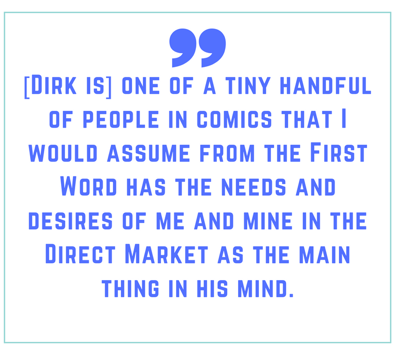
Here’s the thing: I really love and admire Dirk and his work over the years, andAlso, the actual book sounds really good – especially for my main store, where I can very much picture this going on to be a strong perennial seller.
I also want to say that Diamond and IDW are being kind of impressively innovative by having DCD fulfill retailer orders placed on Kickstarter in what I suspect is a way where both of them are making less money than they would have in a traditional distribution arrangement.
But, having said all that praise: fuck buying comics through Kickstarter as a retailer from a major publisher!
We’ll do it, sometimes, for the extremely rare super small press book that wouldn’t have the vaguest chance of existing, and won’t have “normal” distribution, if it weren’t for KS, but you’ll have a pretty impossible time convincing me that this is an analogous situation.
Let me be very blunt here: with very few exceptions, the only reason I ever support KS books a retailer is as a “charity” – where the point isn’t whether or not I ever end up making a profit on that book, but where I’m essentially acting as a patron because it’s a thing that the market needs. But IDW does not need my charity. IDW is a media company that’s producing TV shows. From that ICv2 report on their quarterly filing, IDW grossed nearly $17 million dollars last quarter. That this isn’t widely seen as a complete subversion of what Kickstarter is surprises me to my core. Crowdfunding is the last way a media company should be funding the creation of art, in my point of view, especially since crowdfunding inherently removes the largest and most active fans from any potential retail sales – because they’ve already bought the book!
Further, the nature of the crowdfunder inherently breaks How Retail Works in that we’re expected to pay up front for material that could be months down the road. For most small businesses, Cash Flow is the prime consideration for any asset acquisition – if you can’t Turn your inventory, and quickly, you’re not going to stay in business long as a brick and mortar retailer. Buying from a distributor often affords you terms of 30 days or more, so being asked to pay in advance is a giant step backwards for most stores.
If “Charity” is off the table (as it is here), then “commerciality” is the only reason left to me in determining how and why and what to rack. Like I said, this is a book that I think I can sell well, but it’s almost certainly not going to be a First Week Wonder; it looks to my eyes as a slow and steady burner – we’ll sell one, then will be a week or more to sell another, but it will sell steadily like that for a year or three if its available and in stock. There’s not any real valid reason for me to front-load my stock, as a result – I want to buy this book “Just In Time”, like I would buy any other perennial.
But the way that IDW is structuring this deal is that this book won’t be available in any other way than through Diamond. Now, hopefully at least some of you know that IDW moved its “bookstore” distribution to Penguin Random House this year, but the thing that maybe most of you don’t know is that this means it is much smarter for DM retailers to not order backlist from Diamond as a result. There are two reasons: first and foremost is that Diamond assesses something called a “reorder penalty” of 3% on… well, on all reorders. Now, most of the “Premier” publishers actually pay that 3% invisibly to most retailers…. But not IDW.
The second reason is shipping. Penguin Random House offers free shipping (on orders as low as $100 at retail, which makes tiny reorders very very efficient), while Diamond charges – and at a cost that historically ends up being something like 2.5% for me. Add it together, and it is an effective 5.5% worse discount buying restock on IDW books from Diamond, rather than PRH.
(Seriously, if you’re a retailer and you haven’t looked at this yet, I really would do so right away – every point of margin counts, and IDW is not the sole “other” publisher that PRH handles!)
So I will only be able to buy the book from pretty much the most expensive possible option for me, and it becomes, defacto, the IDW item with the lowest percentage return-on-investment.
My fear is that this becomes normalized enough that IDW, or even other publishers, start thinking that this is an actual sensible way to publish – it isn’t. And moreover, the idea that IDW is going to serialize this book quarterly, launching a fresh kickstarter for each of the first four volumes, seems deeply problematic to how purchasers appear to buy – it also seems to be contrary to the very nature of being a kickstarter, which isn’t built to fund the ongoing creation of a thing.
I’d like to sell this book, but I’m not interested in Kickstarting it.
**************************
Brian Hibbs has owned and operated Comix Experience in San Francisco since 1989, was a founding member of the Board of Directors of ComicsPRO, has sat on the Board of the Comic Book Legal Defense Fund, and has been an Eisner Award judge. Feel free to e-mail him with any comments. You can purchase two collections of the first Tilting at Windmills (originally serialized in Comics Retailer magazine) published by IDW Publishing, as well as find an archive of pre-CBR installments right here. Brian is also available to consult for your publishing or retailing program.
[The views and opinions expressed in this column are those of the author and do not necessarily reflect the views and opinions of The Beat.]


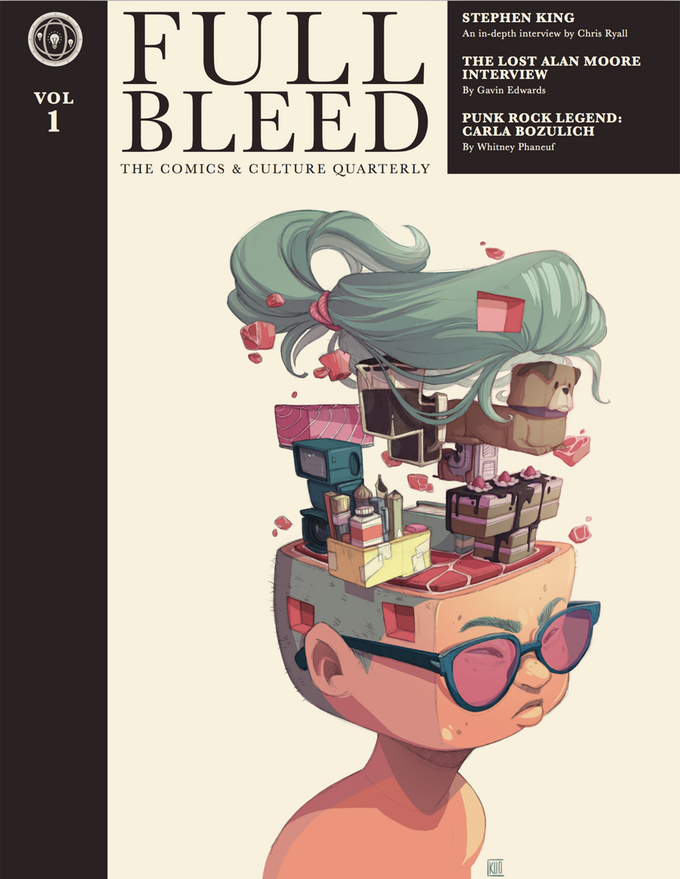
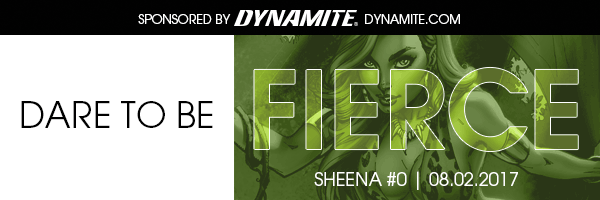


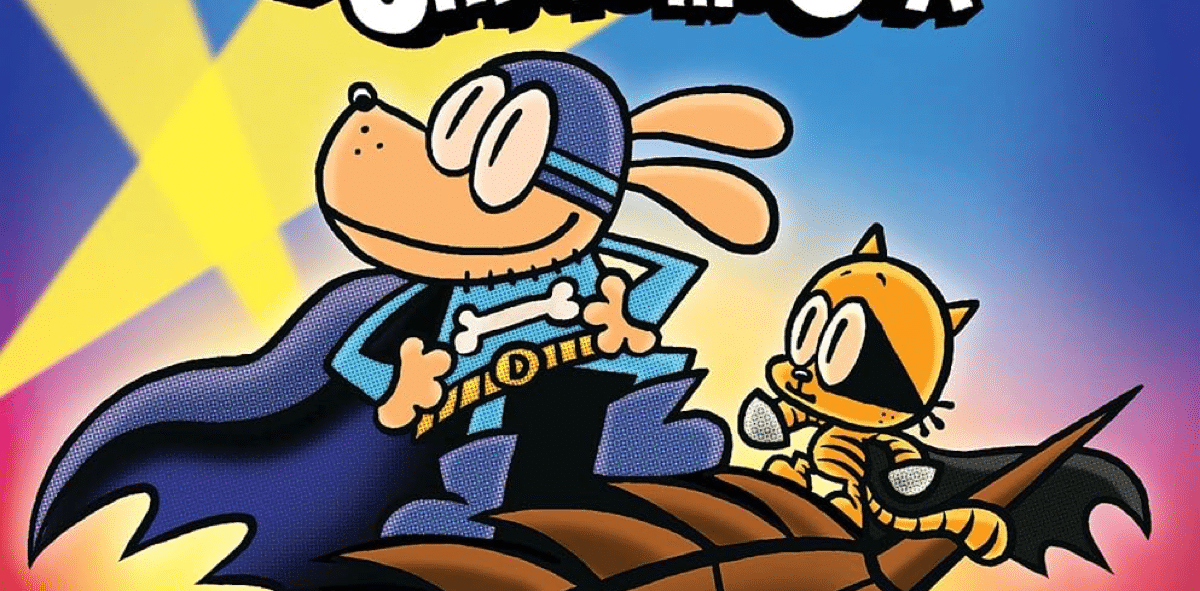


whenever i see any established publisher kickstarting a title it says to me “we think this is cool, but we’re not willing to use our line of credit or cash on hand to make it because it might break even at best” And who wants to back a project that the publisher can’t even bother to get behind? Makes you wonder about the quality like a straight to Netflix movie.
While I’ve used the “major hits = cash flow = more sampling” theory in the past — Bone #1 was preordered with cash from X-Force #1 — I accept your premise that most retailers don’t order that way. That said, the overall numbers have usually suggested the effect is present, so I figure it is coming from the demand side: when the major publishers aren’t doing well, a certain number of their customers simply don’t show up, meaning the ancillary purchases they make don’t happen. These customers don’t spend 100% of their money with the Big Two, but they spend enough that when they’re unhappy with them, they simply don’t show up. Their dollars are no longer in play for anyone else.
Put another way, yes, if the popcorn machine at the theater is broken, you should sell more Skittles. But for these customers, the Big Two are the movie projectors, and if they don’t think those are working, they’re never in the house.
The question is how many readers fit into that category, and I think some readerships are more loyal than others. Marvel was originally the only publisher down for the year in the DM; by August there were just some specific ones (including Image, Dark Horse, and Dynamite) that were still up. If your business is built around them, odds are foot traffic isn’t that much affected — but nationally, I suspect regression analysis would find the Big Two significantly impact their average rival’s sales.
JJ: The thing is that if one is doing compelling comics, the audience’s desire for them should rise above the mere “coat-tail effect”. Is there *some* loss due to coat-tailing? Oh, sure! But when comics are actively desired, it doesn’t matter what other publishers are doing. In my experience.
-B
Worth reading and thinking about, as always, Brian. My 7th grader and I have enjoyed seeing great new comic shops and friendly old favorites thriving by offering more, not less, diversity. (And moving more vinyl and plastic doesn’t mean old guys like me can’t still find bound paper.)
Oh, yeah, know what else is liberating? Not having to read/write/draw every variety of sweet water from Coke and Pepsi.
And thanks for pointing out that PRH is retailer-friendly, at least from your POV. (I have a book coming from that company next year…)
I hadn’t realized IDW was intending to do a kickstarter every quarter for Full Bleed. I know some of the rewards include a year’s subscription, so they wouldn’t have those patrons available for the next three dips into the wallet.
Full Bleed looks like a great project…but one I hope I’ll be able to buy from my retailer sometime down the road.
Brian, you’re looking at this from a pure comics store perspective. I don’t think IDW was talking about you. Your type of store is getting rarer by the day. They’re talking about the comics+table top games and comics+games+video games+etc… retailers. Those guys are looking at the big 2’s constant failures and they’re cutting their racks.
If you’re carrying multiple categories and one is woefully underperforming, do you keep wasting labor, money and square feet of floor space on it? No, you cut it and re-purpose those resources for something else.
The retailers that are cutting back due to that downward pressure are thinking “If I dump that wall shelf over there I can put in another TCG singles case. If I cut those racks over there I can put in two more tables so I can run bigger events. If I cut that row of racks I can finally start stocking Warhammer 40k.”
TL;DR the woeful under performance of the market leaders is pressuring multi-category retailers who do stock comics to reduce their commitment to the category.
Excellent article, as always. The top half about how a publisher exists in the market was fascinating to me.
As far as Full Bleed, I really want to check it out, but I don’t feel right with this Kickstarter. Why but from IDW at full price and not pay the same price at a retailer where the retailer gets a few bucks from it?
And save on shipping, to boot!
I’m not a comics retailer,and I’m happy to take most of your critique of IDW as fair. But if they are having a quarterly or yearly drop in profits, and this identity problem of theirs has been around for a while, it wouldn’t necessarily explain the whole of their current profit drop. As a customer,I do think there are certain things that draw me into a shop, and then I buy other things also. For me,in the late 90’s and early 2000’s, I only wandered into shops hoping there was something new from Alan Moore. Now I hit the shops,mostly, hoping for more exciting Image books and end up buying Aftershock and Oni along the way.
Texas: “TL;DR the woeful under performance of the market leaders is pressuring multi-category retailers who do stock comics to reduce their commitment to the category.”
Sure, maybe — but is that class of retailers moving any appreciable “weight” of comics in the first place? Enough to change overall pub numbers by the discussed amount? If you’re willing to throw out the baby with the bathwater, then most likely the baby isn’t anything significant in the first place. (Ew, ugly metaphor)
Less than 20% of the venues sell something like 80% of the comics sold (from all publishers), as far as I know.
-B
Brian: First off, thank you for taking the time to respond.
I know of 3 retailers that have slowly transitioned away from pure comics over the course of 22 years. I’ve been shopping at these three shops for most of my life, first as an avid reader of comics, later as a tabletop gamer who sometimes buys trades and the rare floppy.
Shop One: This is where I fell in love with Eddie Brock Venom. This shop is also where I got exposed to Decipher’s Star Wars TCG. This is my first comic shop. Over time, this place has almost completely dropped floppies. In 1995, when TCG’s were barely a thing, and even comic readers thought DnD players were nerds, comics dominated the square footage of the store.
In 2017, the store is in the same place (they even took over the neighboring unit), but the floppies are just about gone. Shop One now has 2 racks and a sub box for floppies. What does all that space get used for? Trades, table-top gaming (shelves and play area), manga, and a regrettable purchasing incident involving Funko Pop figures.
Shop Two: This is where I first picked up a bunch of Punisher back issues out of a long box. These guys have tried the hardest to stay purely comics, and they have mostly succeeded. They lost a few locations in the various crashes and slumps in the industry, have moved a few times, but they keep plugging at it. In the 90’s they had a very tiny corner for table-top. Now it’s about half the store. They do great on floppies, but they’re also the place to go for legacy MtG in my neck of the woods. It still remains the only place I’ve actually seen a booster box of Visions in the last decade. If you know about legacy, you know it’s big dollars. I’d call their floor space at about 50% tabletop, 40% comics (more biased towards floppies than trades) and 10% collectibles. Pretty respectable commitment to the category.
Shop Three: This shop is ran by a very shrewd business man who’s been in the business for a long time. Over 30 years they’ve grown, expanded, and consolidated and now they are in a location with more square footage than your average 10 aisle Walgreens including the stockroom and pharmacy. The store layout here is really smart. He segregates us tabletop nerds away from the comic shoppers. The store is basically split in two, and in a way that guides people naturally to where they’re trying to go. If you’re looking for comics, that’s the back corner of the store. You have to walk past all the comic related collectibles to pick up your subs, grab back issues, or check out what’s new. It’s smart merchandising and a proven sales driver in retail (why do you think the pharmacy in drug stores is always caddy corner to the front door?). Overall we’re looking at a split of 50% table top with huge events to justify the huge square footage, 35% collectibles arranged to funnel you to the 15% of the store that is actually comics.
As to a little bit about me and my experiences, I’m a retail veteran who now handles business liquidations. The “turn stuff into money end”, not the legal end of the matters. I’m a nerd for business processes, and the rationale behind decision making. I love your column for showing how the other side of the store is run.
“Less than 20% of the venues sell something like 80% of the comics sold (from all publishers), as far as I know.”
When did it end up like that? Was it the speculator crash in the nineties, or the rise of e-commerce?
As a buyer in Australia, Kickstarter is essentially useless to me. If I buy the print version of something, the postage to Australia will be well in excess of the cost of the item. If I buy the ejecting version it will be on some platform I’ve never heard of and I have to manage myself.
I managed to stuff up my Kickstarter Uber downloads, and have just purchased them properly in comixology. I got a refund from the Ryde for a book I had bought for $30 which was going to cost them $90 to send to Australia.
Kickstarter kills your international sales. Except for the die-hard fan.
http://www.penguinrandomhouse.biz/publisherservices/clients/index.html
Archie, DC, Dark Horse, IDW, NoBrow (2018), Kodansha, Titan, plus nerdy Quirk and Wizards of the Coast.
This also includes the occasional GN title from regular publishers like National Geographic and Rizzoli.
Not to mention titles from PRH’s houses and imprints, like Pantheon, Crown, Ballantine.
The problem with this particular Kickstarter is that many libraries and independent bookstores would be interested in this series.
IDW should overprint the first volume, as well as announce the first four issues simultaneously, so that libraries can order all at once.
According to IDW their objective is to build a subscriber base for FULL BLEED by reaching out “directly to fans.” I can’t imagine many comics retailers will want to help IDW plunge a knife into the back of the direct market.
LL
Great article, its a nice change of pace. I would love an article dissecting Valiant if possible. I really enjoy their offerings even though i do have some grips with them. I feel like even their worst book is better than the majority of what marvel offers.
re.: “If Marvel and DC are doing well, then there is more cash in the marketplace to “experiment” with.”
I think that’s generally True because if they are both doing well … there are generally more Eyeballs/customers around. Who would be willing to look at and try other things.
yours is probably the rare store that just has lots of customers and traffic in general. So you’re able to gear customers to other products. Namely independents.
For a lot of stores, when there’s less interest in Marvel and/or DC, there are Less customers, period.
Just an idea, from my own experience.
Comments are closed.